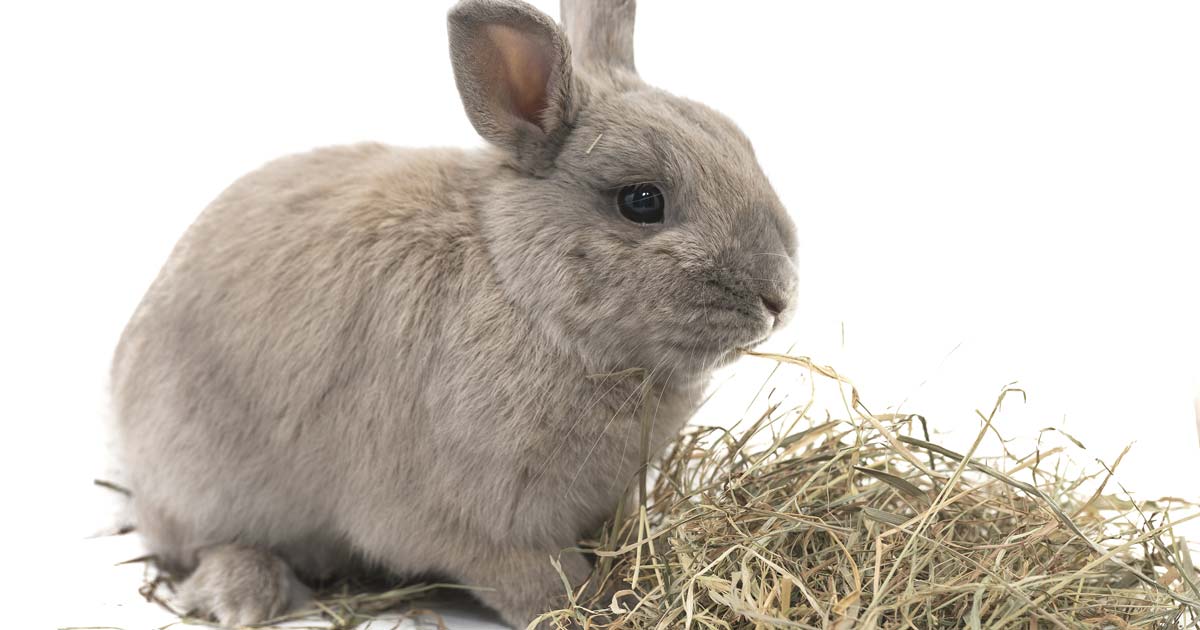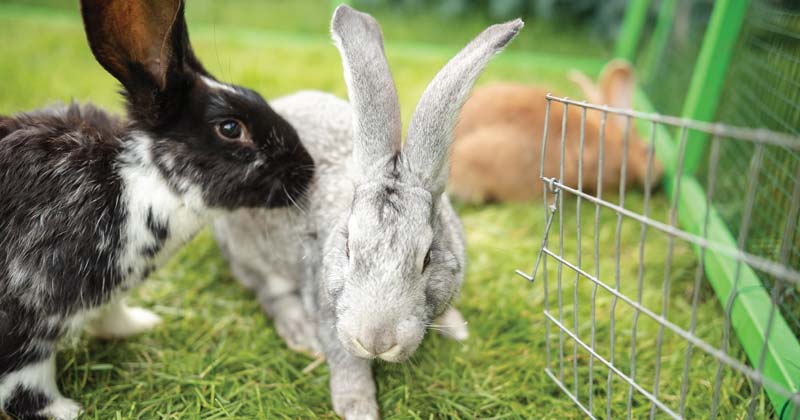6 May 2020
The UK has around one million pet rabbits, and a growing number of practices are capitalising on the lack of care and attention some receive. Research has shown many owners seek out practices that specialise in rabbit care over those who don’t, so it’s worth investing time and thought to make sure they choose you…

Image © Artsiom Petrushenka / Adobe Stock

Most vets graduate with a relatively basic level of rabbit knowledge, despite the fact most will encounter rabbits in their practice on a daily, or at least weekly, basis.
While a steady increase has occurred in the number of rabbits registered with a vet (71% this year against 56% in 2001), many admissions are still made as a result of preventable diseases.
The most common causes of death recorded by vets are fly strike (10.9%), anorexia (4.9%), collapse (4.9%) and gut stasis (4.3%). The most common medical issues are overgrown nails (16%), overgrown molars (7.6%), dirty bums (4.5%), overgrown incisors (4.3%) and gut stasis (4.2%). A common theme exists here: diet.
Most of the issues rabbits are admitted into practice for are associated with poor diet, and it’s widely recognised that nutrition is a key welfare issue to be addressed in rabbit ownership.
Despite the complexities of their digestive system, advising on the best diet for rabbits is comparatively simple. Rabbits should be fed a diet that closely replicates their natural diet in the wild: constant access to high-quality feeding hay (which should make up between 85% to 90% of their diet) and water. This should be supplemented with high-quality nuggets, fresh leafy vegetables and the very occasional treat. Where possible, rabbits should be encouraged to forage for their food to help keep them stimulated.
Hay is absolutely integral to a rabbit’s diet for a number of reasons. Rabbits are prone to dental issues and their teeth grow continuously throughout their lives. Gnawing at hay helps wear their teeth down, preventing overgrown or misaligned teeth (known as malocclusion). Molar malocclusion and incisor malocclusion can both be fatal if they are not identified and treated. As a prey species with limited means of communicating, rabbits often suffer in silence and eventually stop eating, which causes further health issues through reducing gut motility, leading to increased pain and, eventually, death.
It is widely known as “rabbit food”, but research has shown rabbits fed muesli diets will selectively feed, which is where rabbits only eat the high-sugar elements of the muesli mix.
Selective feeding has been linked to a variety of potentially fatal health issues in rabbits, ranging from gut stasis due to slower gut motility, obesity and even fly strike as a result of uneaten caecotrophs.
Muesli mixes remain popular due to their palatable appearance, convenience and comparatively low price. If you encounter any rabbits in your practice that are still being fed muesli, it is imperative that the food is completely phased out in favour of a diet rich in hay, supplemented with good-quality nuggets, over a four-week period.
One of the main challenges you may encounter with muesli feeders is the difficulty that arises from encouraging rabbits to eat more hay as an alternative. Despite the simplicity of their dietary requirements, rabbits can be incredibly fussy eaters and inherently suspicious of new or different foods.
Encouraging natural foraging behaviour, which can be done by placing hay in hanging baskets or willow balls, will encourage rabbits to play for their food, emulating their behaviours in the wild.
Be sure to ask owners about the type of hay any rabbits you encounter in practice are being fed. The quality of feeding hay can vary dramatically, but many owners are unaware of this, with purchasing largely driven by price. High-quality Timothy and meadow hays are the most suitable (and enjoyable) for rabbits.
Members of the Rabbit Welfare Association and Fund (RWAF) can apply to feature on the RWAF’s list of rabbit-savvy vets and become a Silver or Gold Rabbit Friendly Practice.
Vet Richard Saunders will oversee an assessment of practice facilities and vets that will be judged on specific criteria, spanning rabbit wards and waiting rooms to pain management, diagnosis and veterinary skills.
Rabbits are at risk from a variety of fatal diseases. The three biggest killers are rabbit haemorrhagic disease virus (RHDV); a second, mutated strain of the virus (RHDV2) and myxomatosis. Due to the highly infectious nature of these diseases, rabbits must be vaccinated against them – especially as rabbits with RHDV2 display few, or no, symptoms and can die within 24 hours.
Feedback from rabbit owners who were contacted as part of this year’s Rabbit Awareness Week Protect and Prevent campaign highlighted areas of misinformation that require addressing by the veterinary sector. Far too many rabbit owners are still being incorrectly advised on the proper vaccinations they require – if the owners even book their vaccinations in the first place.
Vaccination figures are still shockingly low for rabbits (current compliance levels suggest slightly more than 4 out of 10 vaccinated rabbits are not protected against RHDV2), and feedback from owners has highlighted some vets failing to convey the seriousness of vaccinating against RHDV2 where they have not encountered it in practice.
Both practices and rabbit owners need to be made aware that RHDV2 is now more common than RHDV, and vaccination covering myxomatosis, RHDV and RHDV2 is essential as a result.
RHDV2, in particular, is highly infectious and has been reported all over the UK. There is no excuse for not vaccinating rabbits against this horrific disease. As it is transferred via contact, whether that is via insects or entering the house on the bottom of shoes, it is imperative that even rabbits living indoors are vaccinated against RHDV2.
In addition, every practice should be stocking the appropriate vaccines to protect the rabbits in their practice area.
Nobivac Myxo-RHD Plus, released in 2020, covers all three viral diseases and is a single vaccine to be administered annually. This vaccine can be given as a single dose from five weeks of age onwards, with immunity shown to develop by three weeks after that.
It is essential that vets and vet nurses are conveying the importance of vaccinations and annual boosters to every client they encounter with pet rabbits.

Rabbits need access to a large open space that provides them with the right environment to display natural behaviours, such as foraging, burrowing and digging.
As a prey species, rabbits must feel safe in their environment and have plenty of space to hide – whether that is in tubes, boxes, bedding or additional housing. Outdoor “runs” should be attached to hutches so rabbits can choose whether they want to be outdoors or indoors, and care should always be taken to ensure outdoor environments are secure and protected against the threat of predators.
In total, 84% of rabbits live in hutch sizes that are smaller than the recommended size provided by the Rabbit Welfare Association and Fund (RWAF). Be sure to advise any rabbit owners visiting your practice about the minimum recommended hutch size provided by the RWAF, rather than the legal minimum standard, as rabbits kept in cramped conditions can suffer with stress and frustration. Rabbits kept in poor accommodation are at risk of developing obesity and skeletal abnormalities.
Rabbits are intelligent and highly sociable animals that should be kept in a minimum of same pairs. Same-sex and mixed-sex couples all work well, providing the rabbits are neutered – which they always should be.
Rabbits have unique personalities and these should be considered during the bonding process. Developing strong relationships with good, local rescue centres can help provide support during the bonding process.
Rabbits kept on their own will become lonely, and this may lead to depression and stress, which can have a negative impact on health.
Unfortunately, it is challenging to treat depression in rabbits other than advise on remedying their loneliness through adding a companion. If you encounter an owner who is concerned about the behaviour of a lone rabbit, signs such as excessive hiding, overgrooming and lack of appetite may indicate stress and depression.
Male and female rabbits should be neutered from four months of age and five months of age, respectively, so it is important that care is taken in mixed-sex pairs to avoid early pregnancies. Rabbits should not be reintroduced immediately after neutering – male rabbits can take up to six weeks to become sterile after being neutered.
Neutering is important because, as well as preventing unwanted litters, it prevents unwanted behaviours, such as aggression and fighting, too – especially among males. Unneutered female rabbits have a high risk of developing uterine cancer, which is totally prevented by spaying.
The Rabbit Awareness Week (RAW) website has lots of downloadable materials that can be printed and displayed in waiting rooms, as well as information that may be repurposed for any internal guides.
Many rabbit owners will favourite practices with separate waiting areas for small animals. Separate waiting rooms, away from the sights and sounds of noisy prey animals, will provide a less stressful experience for rabbits. If space allows, having a separate waiting room for rabbit owners can make your practice worth travelling to. This is a prerequisite for being an accredited RWAF Rabbit Friendly Practice.
Use your practice social media channels to your commercial advantage to drive engagement with new and existing clients, and help educate rabbit owners.
Taking part in the annual RAW campaigns can help boost footfall into your practice, too. Every June, RAW addresses a major issue affecting the lives of rabbits in the UK with thousands of veterinary practices supporting the campaign by offering free or discounted health checks.
Taking part in RAW is an opportunity to showcase your commitment to rabbit care and gain a commercially valuable reputational boost from PR opportunities.
Rabbit Awareness Week (RAW) was created by Burgess Pet Care nearly 15 years ago to improve the lives of rabbits living in the UK.
RAW addresses a key welfare issue facing rabbits every year, and vets are able to benefit from an extensive selection of free marketing materials, samples and PR support throughout the week. Vet Gemma Graham said: “RAW offers a great opportunity to engage with our clients and educate the public on the needs of these specialised creatures.
“The rabbit clients who get involved with us during RAW each year have given us such positive feedback.”
Ultimately, any kind of activity your practice is involved in that promotes responsible ownership and better care of rabbits will help you establish a trust and rapport with rabbit owners.
Plenty of ways exist (and many of them are free) to brush up on your rabbit knowledge – from the free CPD hosted on the RAW website to the RWAF Conference and CPD roadshows that take place throughout the year.
Demonstrating your excellence in rabbit care will improve the lives of these animals and help create long-standing relationships with owners – all while boosting your commercial potential within this largely misunderstood target market.